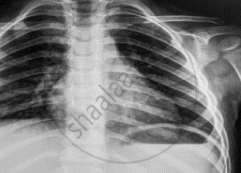Advertisements
Advertisements
प्रश्न
Solve the numerical problem.
Calculate the wavelength in nm of an X-ray wave of frequency 2.0 × 1018 Hz.
उत्तर
Given: c = 3 × 108 , ν = 2 × 1018 Hz
To find: Wavelength (λ)
Formula: c = νλ
Calculation: From formula,
λ = `"c"/ν=(3xx10^8)/(2xx10^18)` = 1.5 × 10−10 = 0.15 nm
The wavelength of an X-ray is 0.15 nm.
APPEARS IN
संबंधित प्रश्न
What role dose infra-red radiation play in maintain the Earth’s warmth
If the earth did not have an atmosphere, would its average surface temperature be higher or lower than what it is now?
Why are infra-red waves often called heat waves? Explain.
Name the region beyond the red end of the spectrum.
Name the region beyond the violet end of the spectrum called.
Name three properties of ultraviolet radiations which are similar to visible light.
Name of physical quantity which remains same for microwaves of wavelength 1 mm and UV radiations of 1600 Å in vacuum.
The energy of a photon of a characteristic X-ray from a Coolidge tube comes from
Consider a photon of continuous X-ray and a photon of characteristic X-ray of the same wavelength. Which of the following is/are different for the two photons?
What potential difference should be applied across an X-ray tube to get X-ray of wavelength not less than 0.10 nm? What is the maximum energy of a photon of this X-ray in joule?
(Use Planck constant h = 6.63 × 10-34 Js= 4.14 × 10-15 eVs, speed of light c = 3 × 108 m/s.)
The X-ray coming from a Coolidge tube has a cutoff wavelength of 80 pm. Find the kinetic energy of the electrons hitting the target.
(Use Planck constant h = 6.63 × 10-34 Js= 4.14 × 10-15 eVs, speed of light c = 3 × 108 m/s.)
The short-wavelength limit shifts by 26 pm when the operating voltage in an X-ray tube is increased to 1.5 times the original value. What was the original value of the operating voltage?
(Use Planck constant h = 6.63 × 10-34 Js= 4.14 × 10-15 eVs, speed of light c = 3 × 108 m/s.)
The stopping potential in a photoelectric experiment is linearly related to the inverse of the wavelength (1/λ) of the light falling on the cathode. The potential difference applied across an X-ray tube is linearly related to the inverse of the cutoff wavelength (1/λ) of the X-ray emitted. Show that the slopes of the lines in the two cases are equal and find its value.
(Use Planck constant h = 6.63 × 10-34 Js= 4.14 × 10-15 eVs, speed of light c = 3 × 108 m/s.)
Write the range of the wavelength of the following electromagnetic radiations:
(a) Infrared rays
(b) Ultraviolet rays
(c) γ -rays
Write one use of each of the above.
Name the radiation of the electromagnetic spectrum which is used for the following:
To photograph internal parts of the human body and Give the frequency range
Name two sources of ultraviolet radiation.
Name two sources of infrared radiation.
Give one use of electromagnetic radiations in Infrared radiation.
Choose the correct option.
The EM wave emitted by the Sun and responsible for heating the Earth’s atmosphere due to greenhouse effect is
Answer briefly.
What are radio waves?
Solve the numerical problem.
Calculate the frequency in MHz of a radio wave of wavelength 250 m. Remember that the speed of all EM waves in a vacuum is 3.0 × 108 m/s.
Calculate the wavelength of a microwave of a frequency of 8.0 GHz.
Name the e.m. waves which are suitable for radar systems used in aircraft navigation. Write the range of frequency of these waves.
Write two uses of the following radiation.
Gamma rays
Which one of the following electromagnetic radiation has the least wavelength?
Identify the electromagnetic wave whose wavelength range is from about 10-3 m to about 10-1 m. Write one use of this.
Identify the part of the electromagnetic spectrum which:
- produces the heating effect.
- is absorbed by the ozone layer in the atmosphere.
- is used for studying crystal structure.
Write any one method of the production of each of the above radiations.
What is the speed of radio waves in vacuum?
Name the electromagnetic radiation that has been used in obtaining the image below.

